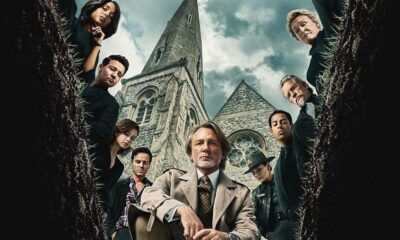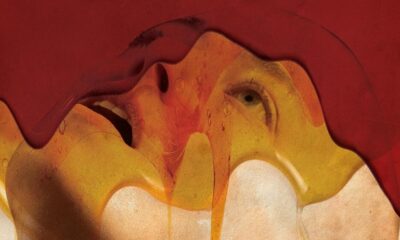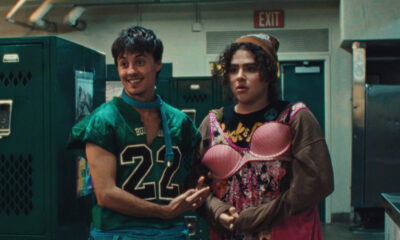

Featured Review
In The Lost Lands ★★★★★
Released: 14 March 2025
Director: Paul W.S. Anderson
Starring: Milla Jovovich, Dave Bautista
There’s a certain kineticism to Paul W.S. Anderson’s work that is still unmatched in contemporary digital cinema: whether it’s Monster Hunter’s sweeping action in the deserts of Namibiaor the dizzying hyperreality of the “point and shoot” simulation in Resident Evil: Retribution, Anderson’s visual language remains as expressive and inimitable as ever. Naturally, it also leads to the wildly divisive reception of his work, as this brand of overtly visual storytelling has become passé in our cynical, aggressively postmodern cinematic environment. It really feels like these days, all of the exciting action cinema is hidden in the direct-to-streaming section, with Anderson’s work standing tall as the last bastion of defiantly theatrical action. If nothing else, Anderson’s latest effort, In the Lost Lands, proves one thing: this filmmaker’s sensibilities haven’t aged a day, as it’s still a thrill to watch expertly staged set pieces and stunning digital photography that has the power to transport you to a world unlike any other.
As the fantasy-esque title may indicate, In the Lost Lands is an adaptation of George R.R. Martin’s short story of the same name. Positioned as an “adult fairytale” by Anderson, the film focuses on two archetypal outlaws: Gray Alys (played by Anderson’s muse, Milla Jovovich), a witch on the run from the forces of the local Church, and the mighty Boyce (Dave Bautista), an Eastwood-type gunslinger on a mission to retrieve the skin of an unstoppable werewolf. Together, the two find themselves on the road to Skull River — a distant hideout of the deadly lycanthrope.
Here, the two styles collide: Anderson’s motifs about defiance against corrupt systems transform Martin’s story of intrigue and deceit into a sincere and surprisingly touching action-horror adventure. As Boyce and Gray Alys traverse the dangerous Lost Lands, Anderson utilizes the varied environments as storytelling tools: between the lonely saloon/train station as a momentary safe haven or the abandoned nuclear plant becoming a nightmarish trap for the leads, it all feels tangible and lived-in. This expressionist methodology also extends to the way Anderson presents the villainous forces, as the clash of royalty and organized religion is vividly represented through striking sets and regal costuming.

In the Lost Lands also marks the end of Anderson’s collaborations with editor Doobie White (AKA the frenetic cutter best known for his work on the films of Neveldine/Taylor), which lets the film bask in the glory of Anderson’s meticulously framed slo-mo action. The first time we meet Boyce is a riff on a 1960s western: a seemingly typical stand-off becomes a wildly imaginative fantasy onslaught, even down to the inclusion of a two-headed snake that lunges at unsuspecting thugs. While brief and almost devoid of verbal cues, the sequence perfectly encapsulates the outlaw nature of Boyce and his methods, with Bautista nailing the gruff-yet-tender look of the character. We feel as if we’re thrust into this world where nobody is to be trusted — even the characters we’re supposed to sympathize with.
Anderson himself described his visual approach to the film as “Hieronymus Bosch in motion”, and that’s very much reflected in how he utilizes digital backgrounds to tell the story. The world of Lost Lands is a harsh one — death lurks around every corner, a hellscape where hope has become a distant memory. Yet through these shadows, Anderson’s humanistic tendencies shine even brighter, bringing forth the idea of shared pain and compassion between the unlikeliest allies. The script by Anderson and Constantin Werner is rather short on dialogue, but that’s largely by design as the two leads are both deeply scarred and broken, opting to channel righteous anger into violence against the repressive structures that created them.
In a sequence towards the end of the film, the characters find themselves in an abandoned cruise ship: soft light pierces the derelict ballroom, shimmering luminescence reflecting from audibly vibrating chandeliers. It’s a fleeting moment of respite, but one that best exemplifies Anderson’s attention to emotional tonality through visual splendour. Those who seek the cinema of visual excess will find a lot to love in Anderson’s latest — a lost art of poetic storytelling in unfiltered action filmmaking.
-

 Features4 weeks ago
Features4 weeks agoThe World’s End? How The Long Walk/The Mist Mirror Today’s Society
-

 Movie Reviews4 weeks ago
Movie Reviews4 weeks agoLondon Film Festival 2025 – Wake Up Dead Man: A Knives Out Mystery ★★★★
-

 Movie Reviews3 weeks ago
Movie Reviews3 weeks agoI Swear ★★★★★
-

 Featured Review3 weeks ago
Featured Review3 weeks agoLondon Film Festival 2025 – Hedda ★★★★
-

 Movie Reviews3 weeks ago
Movie Reviews3 weeks agoTron Ares ★★
-

 Featured Review3 weeks ago
Featured Review3 weeks agoLondon Film Festival 2025 – High Wire ★★★★
-

 Interviews2 weeks ago
Interviews2 weeks agoDon Worley on Second Chances, Making Movies and Stand-Up Stages
-

 Features4 weeks ago
Features4 weeks agoThe Gentlemen Season Two Reportedly in the Works













